3-Day Okinawa Itinerary – The Perfect Self-Driving Guide to the Main Island Paradise

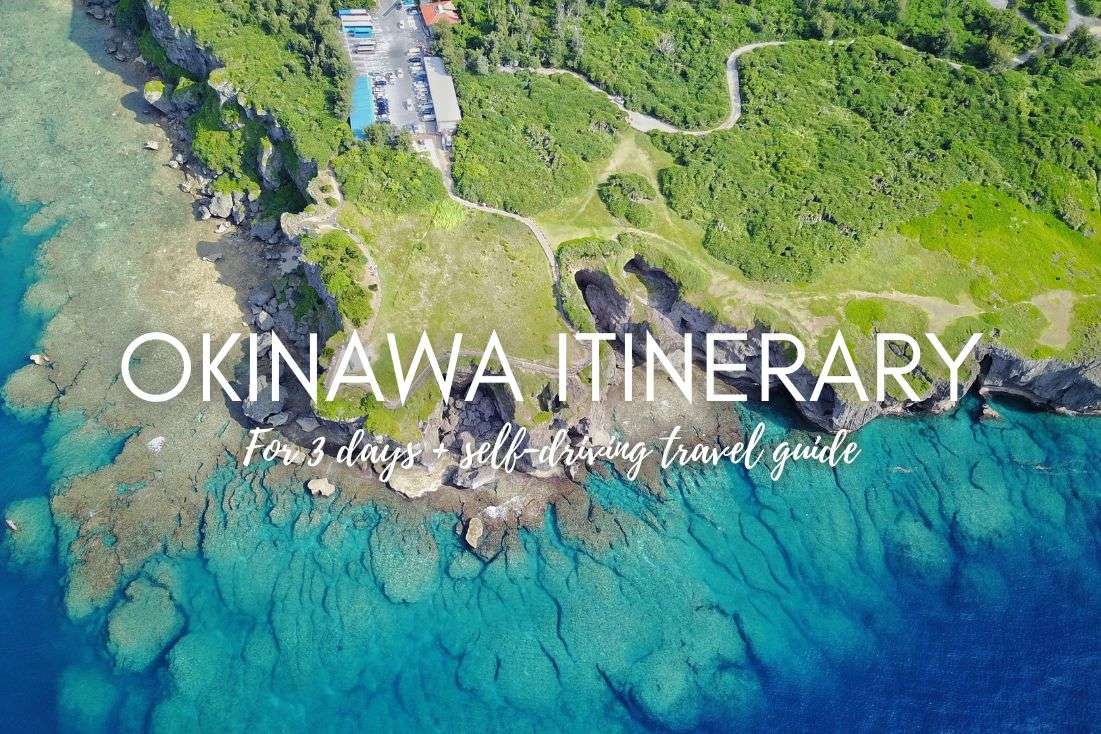
Overview of your 3 days in Okinawa and a map
My top tips for visiting Okinawa
Day 1 of the Okinawa itinerary: Southern Okinawa
Day 2 of Okinawa itinerary: Ocean Expo Park
Day 3 of Okinawa itinerary: Scenic views all the way up to the northern tip
How many days are enough for Okinawa?
We visited Okinawa mainly because my girlfriend was eager to dip her toes in the Pacific, and although I was indifferent to it at first, a little reading turned me into a convert. Okinawa offered an unexpected number of attractions and experiences that made me want to go see it for myself.
Okinawa really is a tropical paradise! Picture Hawaii but with a Japanese twist—tons of Japanese people—check! US aircraft carriers—check! Gorgeous sea and waves—check!
Overview of your 3 days in Okinawa and a map
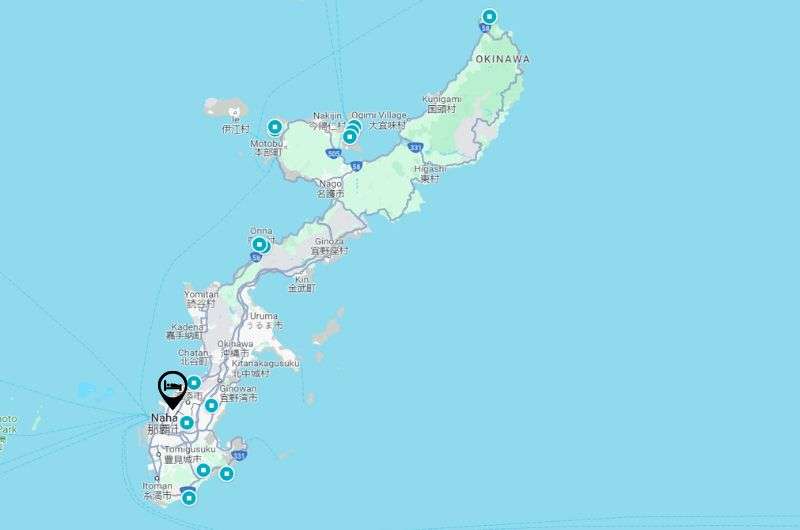
Here is an overview of where all the stops for your 3 days are located. You’ll base yourself in Naha for the entire Okinawa itinerary (Okinawa EXES Naha is where we stayed and absolutely loved it!)
Get ready for a whirlwind tour of Okinawa's best spots over the next 3 days. Here’s the trip plan:
Day 1: Southern Okinawa
- Peace Memorial Park
- Mibaru Beach
- Okinawa World
- Tropical Beach
- Karate Museum
Day 2: Ocean Expo Park
- Churaumi Aquarium
- Ocean Exploration Museum
- Ocean Expo Beach (Emerald Beach)
- Cape Manzamo
- American Village
Day 3: Scenic Views All the Way to the Northern Tip of the Island
- Shurijo Castle
- Nabee Beach with snorkeling and kayaking
- Kouri Bridge Viewpoint and beach
- Cape Hedo
This is a self-drive itinerary, because if you know me at all, you’ll know that I always rent a car wherever I travel to give myself the comfort and flexibility of having my own set of wheels. This Okinawa trip itinerary covers the island in 3 days by making day trips from Naha, where you’ll be based in the best hotel I stayed in in all of Japan—Okinawa EXES Naha. A truly 5-star experience.
My top tips for visiting Okinawa
- Rent a car: Public transport is not your friend here. Book your car well in advance and pick it up at the airport to avoid logistical nightmares. I booked a month in advance and ended up stuck on a bus going to the outskirts of town. Not something I ever want to do again.
- Historical expectations: History buffs will be disappointed—Okinawa gives almost nothing in terms of World War II memorials. In the place of the biggest battle of the Pacific War, I’d expect a lot more. SMH.
- Stay in Naha: It has the best hotels at the best price points, plus it’s where the good restaurants are, and it’s well connected to other spots on the island, perfect for day trips. My top pick? Okinawa EXES Naha.
- Plan your drives: The island is larger than it seems; some drives can take up to 2 hours one way!
- Fly in style: Upgrade to premium economy on ANA Airways for a surprisingly affordable and luxurious experience. The Japanese have a special taste for luxury, where you feel uber-luxurious instead of just regular luxurious! Read my full review of the ANA Airways premium economy experience.
- Beware of Swimming: Swimming at the beaches, the sea is full of creatures that are venomous and trying to kill you, like box jellyfish, stonefish, and sea snakes. My first thought was that I really wouldn’t like to do a WWII beach landing here… is it just me? Anyway, you’re going to want to keep the marine fauna in mind on your Okinawa trip and make sure to swim at beaches with safety nets. There are plenty of them, because apparently most people aren’t into that much adrenaline while beaching.
Day 1 of the Okinawa itinerary: Southern Okinawa
Get the route of Day 1 already mapped out on Google Maps
Main sites visited on day 1: Peace Memorial Park, Mibaru Beach, Okinawa World, Tropical Beach, Karate Museum
Hotel recommendations: Okinawa EXES Naha
Day 1, stop 1: Peace Memorial Park
- Distance from Okinawa EXES Naha: 20 km (11 mi), a 40-minute drive
- Time spent here: 1–2 hours
- Price: JPY 300 (USD 2) for the museum, otherwise free
- Tip: Visit in the morning to avoid the midday heat if visiting in the summer.
What to Expect in the Okinawa Peace Memorial
Alright, let’s kick this Okinawa trip off with Peace Memorial Park—the main WWII memorial on Okinawa. Basically, it's a massive cemetery and open space dedicated to the Battle of Okinawa. Don’t expect flashy WWII memorabilia here—it’s a peaceful park where you can take a solemn stroll among rows of monuments with the names of 240,000 people who died in the battle etched in stone.
Take at least an hour to soak in the tranquility and maybe ponder the sheer lunacy of war—I could’ve easily spent more time had it not been for the insufferable heat. If nothing else, the cliff views are spectacular.
Another part of the park is the Peace Memorial Museum, which gives an overview of events before, during, and after the Battle of Okinawa, and the Okinawa Peace Memorial Hall, a column that has a statue representing peace enshrined inside it.
Day 1, stop 2: Mibaru Beach - Your First Dip in the Pacific Ocean
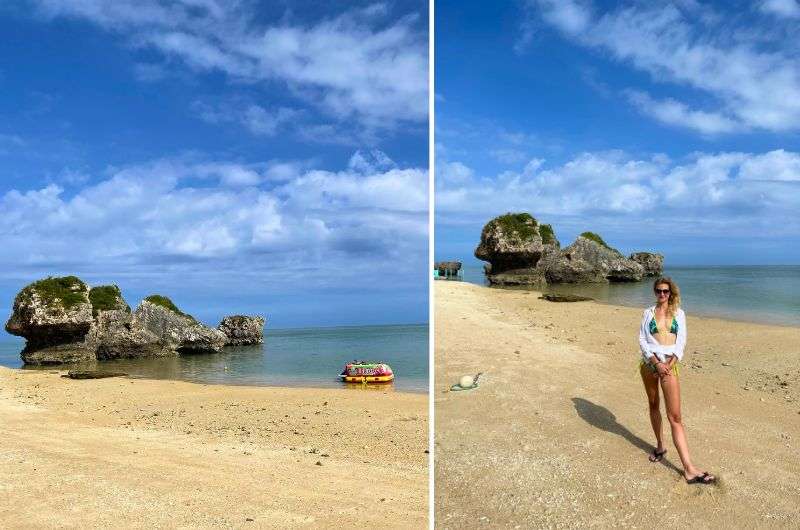
Mibaru, not Maribu!
- Distance from last stop: 11 km (7 mi), a 15-minute drive
- Time spent here: 1 hour
- Price: JPY 500 (USD 3) for parking
- Tip: Bring some water shoes; the beach has rocky areas that can be tough on bare feet.
How to get to the Mibaru Beach
Just drop it into your GPS and follow the route - it leads you right to the beach, where you can literally park a few steps from the sand. It's an easy ride, except the road gets a bit sketchy near the end. I had a brief 'are we lost?' moment, but nope - we were spot on.
What to Expect at Mibaru Beach
Next, we head to Mibaru Beach (is it just me, or is everyone else calling it ‘Maribu’ accidentally?). Parking costs JPY 500. Even if you’re like me and generally indifferent to beaches, dipping your toes here is pretty darn enjoyable. One thing I loved about Okinawa’s beaches was that they were never crowded, and Mibaru is no exception.
The sand at Mibaru is mostly white, sometimes soft, and sometimes pretty rough with larger coral and sharp rocks. The cool rock formations in the crystal-clear water just make you want to go in the shallow waters to explore… just remember not to touch anything you see swimming past you. And if you do see anything… You better get back to dry land, stat!
If you’d like to stay safe but still see what’s out there, consider taking the glass-bottom boat tour. It’s like snorkeling, but you stay dry! There are, unfortunately, also things like banana boats that ruin the tranquility at Mibaru Beach. Then again, it’s a pretty long beach, so it isn’t that hard to find a less obnoxious spot.
It’s a chill spot to unwind and pretend you're on a postcard. There isn’t much in terms of facilities besides a simple restaurant or two.
Day 1, stop 3: Okinawa World
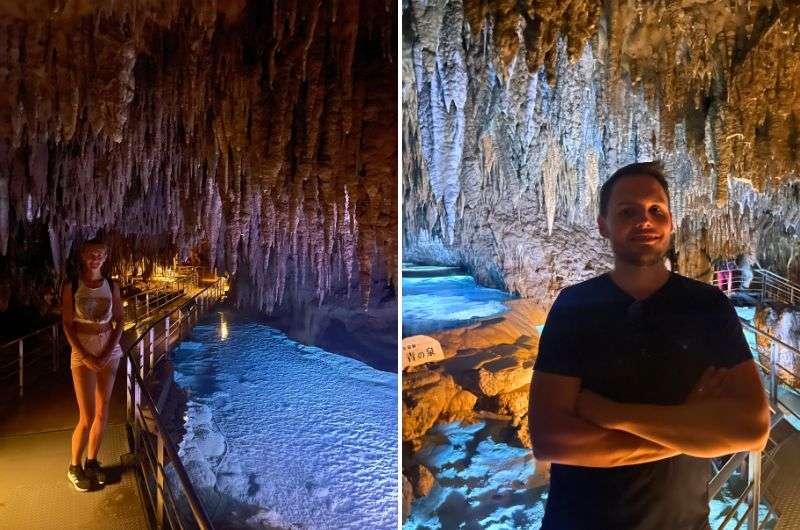
The Gyokusendo Cave is very long and full of water... loved it!
- Distance from last stop: 6.5 km (4 mi), a 10-minute drive, just drop it in the navigation
- Time spent here: 2–3 hours
- Price: JPY 2000 (USD 12.50)
- Tip: Expect to get slightly wet in the cave. Don’t worry, any water will evaporate right off you the moment you step outside again (you can tell we visited Japan in August).
This next stop on your first day in Okinawa is purposefully planned so you can hit the beach first and then cool off in the cave. So, from Mibaru, it's on to Okinawa World, a place that’s part cave and part zoo—basically, it’s all the things I love in one!
Plus, some cultural experiences that I mostly missed, but you can include if they sound interesting to you. I really enjoyed this place, mainly thanks to its amazing cave and a… petting zoo? You like petting venomous snakes, right?
Pro Tip: Okinawa World has a huge parking lot, so no worries about finding a spot even on a busy day. And it was very busy, even on a weekday.
What to Expect at the Okinawa World
The main attraction is the Gyokusendo Cave, which is absolutely packed with people. This cave is enormous—5 km (3 mi) long, with a giant stalagmite that's 31 m (100 ft) in diameter! I love me a long cave! It's stunningly lit and has a sizeable underground river, adding to the drama. After the initial crowd, people tend to spread out.
Pro tip: If you see a group of school kids, don’t panic and get ahead of them—they then serve as a handy barrier between you and all the other people that aren’t brave enough to get ahead of them. Instant crowd control (for you, not for them)!
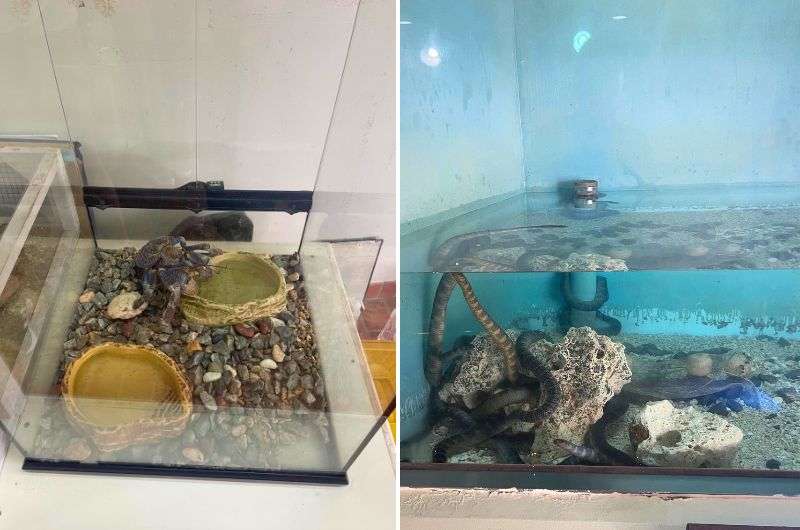
My favorite pets!
Expect to get a bit wet since the cave is very active with dripping water, and you’ll even find fish swimming in there. They’ve really made this one of the seven wonders of Okinawa. Beyond the cave, you can explore areas dedicated to tropical fruits, traditional glassblowing, and snake exhibits.
Speaking of snakes, they have a large terrarium where you can see (and sometimes handle) some of the venomous ones. They even have super venomous sea snakes and giant bats you won’t see anywhere else.
I spent in Okinawa World almost 3 hours and I would have spent more if I hadn’t planned so much for the day. If you have more days I encourage you to stay longer as there are not many attractions better than Okinawa World.
Overall, Okinawa World is a solid blend of nature, culture, and a touch of adventure—definitely make sure to visit it as part of your Okinawa 3-day itinerary.
Day 1, stop 4: Tropical Beach

And now, let’s go back to the beach. This time to Tropical Beach
- Distance from last stop: 20 km (13 mi), a 35-minute drive
- Time spent here: 1 hour
- Price: 0
- Tip: Arrive before 4 pm to enjoy the beach before it gets too crowded—it’s a popular spot for sunset.
After spelunking and becoming friends with snakes in Okinawa World, you’ll probably want to relax again. Since Okinawa is known for being the beachy paradise island of Japan, the safety-netted Tropical Beach is your spot to finally feel like you can get into the water and have a carefree hour of beach fun!
Something about fearing for your life really sucks the paradise vibes out of a tropical beach stay, am I right?
Located in Ginowan Seaside Park, it’s got all the amenities—showers, restrooms (though they are a little far), and, of course, safety nets. It's a nice place to just chill out and go for a swim. There’s a covered area with picnic tables if you don’t want to sit in the sand the whole time, and it’s also a good place to escape the sun for a bit.
We saw locals busting out the BBQs, and it’s a popular spot to see the sunset, but alas, you have one more stop ahead of you today. But hey, you can see the sun another time, ok? I promise.
Day 1, stop 5: Karate Museum
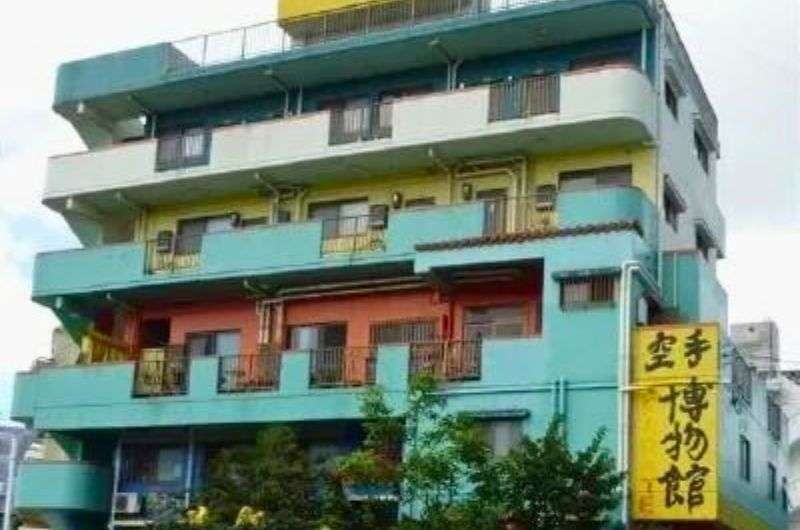
Okinawa Karate Museum’s website
- Distance from last stop: 6.5 km (4 mi), a 20-minute drive—expect traffic
- Time spent here: 30 minutes
- Price: 0
- Opening hours: Mondays, Wednesdays, and Fridays 11 am–4:30 pm; Saturdays 2 pm–4 pm, otherwise closed.
- Tip: Check the opening hours before you go; the museum has limited hours and is closed 3 days a week.
Cap off your first day in Okinawa with a visit to the Karate Museum. Okinawa is the birthplace of karate, and this small museum packs a punch with its collection of old photos, manuscripts, and weapons. It’s on the second floor of Mr. Tetsuhiro Hokama’s dojo (martial arts hall), which he founded 9 years ago along with the museum.
Even just going up the narrow stairs, it all feels very personal, like you’re entering a sacred space… just for karate.
Even if you’re not into martial arts, Hokama Sensei’s enthusiasm is contagious. When you come here, you can’t help but become a fan. There are about 500 artifacts and photos to look at. It’s a quick but fascinating stop that rounds out your day with a bit of local history.
Best hotel in Okinawa: Okinawa EXES Naha
After your first full day in Okinawa, head back to Naha and rest up at the Okinawa EXES Naha. Here’s why I thought it was the best hotel I stayed at during my last trip to Japan:
- Gorgeous, bright rooms where nothing emits light at night—when you sleep in enough hotels, you really notice and appreciate these details!
- The receptionists all spoke English.
- Valet parking—you don’t know you need it until you do! You'll feel like royalty just tossing your keys and watching your car glide away like a modern-day chariot.
- Breakfast is brought to your room. Heck, you can eat it in bed if you want!
- A fantastic pool—I rarely ever use hotel pools, but in Okinawa, with the heat and the deadly creatures out at sea, the pool in the courtyard, lined by couches, was just what the doctor ordered.
Day 2 of Okinawa itinerary: Ocean Expo Park
Get the route of Day 2 already mapped out on Google Maps
Main sites visited on day 2: Churaumi Aquarium, Ocean Exploration Museum, Ocean Expo Beach (Emerald Beach), Cape Manzamo, American Village
Hotel recommendations: Okinawa EXES Naha
Today’s main destination, Ocean Expo Park, is 2 hours away from Naha, so make sure to set out bright and early. The great thing about self-drive itineraries like this one is that you are free to get up when you want, but make sure to leave your hotel room with enough time for exploring!
There are many, many things to see and do in Ocean Expo Park—I’ve chosen my top 2 favorites and added a beach at the end. For a full overview of everything going on, see Ocean Expo Park’s official website.
Day 2, stop 1: Okinawa Churaumi Aquarium

This aquarium was huge and sooo cool!
- Distance from Okinawa EXES Naha: 90 km (56 mi), an almost 2-hour drive
- Time spent here: 2 hours
- Price: JPY 2,180 (USD 14)
- Opening times: Daily 8:30 am–8 pm (9 pm in August)
- Tip: Arrive early, let the crowds go to the shows first while you wander, and then go to the shows when the crowds get unbearable.
You’ll start your second day in Okinawa with a splash by visiting the Churaumi Aquarium, arguably one of the best aquariums in the world. It has indoor and outdoor exhibits full of incredible creatures, and is part of the large Ocean Expo Park.
Traffic and Parking at Churaumi Aquarium
There are plenty of free parking lots in Ocean Expo Park, the most convenient of which is a large parking lot between the aquarium and the museum (your next stop). In the morning, there will probably be a bit of a traffic jam at the entrance (and then another one when you’re ready to leave, but we don’t need to talk about that right now).
What to Expect at Churaumi Aquarium
The main attraction at Churaumi Aquarium is the Kuroshio Tank, a huge tank that offers an awe-inspiring view of sea animals swimming around gracefully. The obvious main stars of the show are the two whale sharks—a male and a female. But you’ll also see a ton of fish and large manta rays. You can see it all through thick acrylic walls or in the Aqua Room, which is basically a glass tunnel under the Kuroshio Tank.
The aquarium is massive and full of interesting information—everything is in English! Besides the whale sharks, I especially enjoyed the sea snakes and the sea turtles (in the outdoor area). And the deep-sea fish exhibit was ultra interesting.
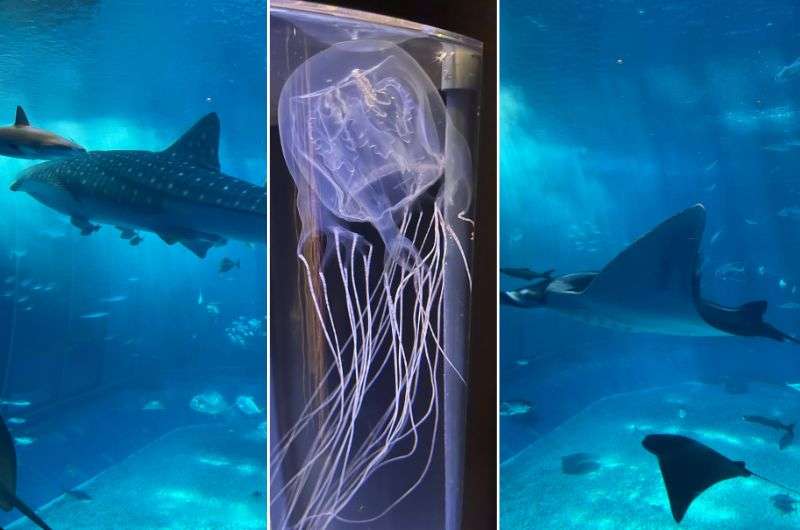
See many sea creatures up close at the Okinawa Churaumi Aquarium
Be ready to share the aquarium with a bazillion other visitors, including kids who seemed to be absolutely everywhere. It seemed though that most people come here first thing in the morning and try to catch the best shows right off the bat, which made it slightly easier for the rest of us to enjoy relatively traffic-less corridors and displays while we stare at fish and read the information.
Don't miss the dolphin show… unless you’re opposed to dolphin shows. It’s free and happens every two hours.
Make sure to download the Churaumi Aquarium app, it’s really well done and interactive, and makes it easy to get around without missing anything or getting lost.
We spent 2 hours at the aquarium, but you could spend even longer there, easily. But it’s time to move on, just slightly, to the Oceanic Culture Museum Planetarium next door.
Day 2, stop 2: Oceanic Culture Museum Planetarium
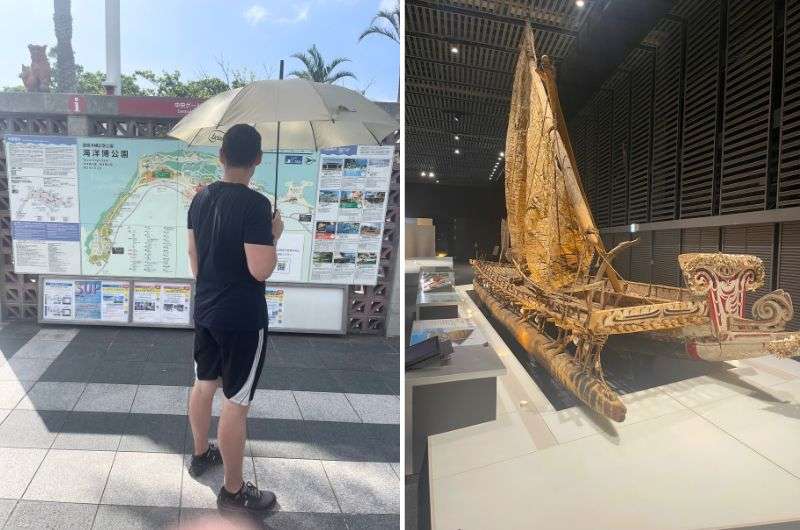
Museum time!
- Distance from last stop: Just a short walk through the park from the aquarium
- Time spent here: 2 hours
- Price: JPY 190 (USD 1.20)
- Opening hours: 8:30 am–7 pm
- Tip: Brush up on your Japanese, because you’ll find zero English at this museum. Alternatively, Google Lens will be your guide.
Just a short walk from the aquarium is the Oceanic Culture Museum Planetarium (what a name!), also part of the fantastic Ocean Expo Park, and one of the most unique museums I’ve ever seen. It’s possibly my favorite museum in Japan! And that’s even though every sign there is solely in Japanese. Google Lens is your friend.
What to Expect at Oceanic Culture Museum
The museum is dedicated to the history and techniques of ocean exploration, showcasing a world-class collection of canoes and other seafaring vessels (Tahitian war canoe, hello?!). So, boats, boats, and more boats, which I personally love.
It also explains the migration patterns and lifestyles of Pacific Islanders and their unique island culture, with detailed timelines and interactive displays, another thing that automatically earns extra points from me.
It was just as amazing as I imagined it, and it was very insightful to learn about the journeys and challenges of the Pacific Islanders. Apparently, they originally started migrating from Okinawa and the Philippines about 6,000 years ago. It’s fascinating to see how their genetics have changed between there and New Zealand.
There’s even a planetarium with scheduled shows.
Beware that the Oceanic Culture Museum Planetarium is huge, so it’s easy to wander around until, well, until you’re too hungry to continue. I spent 2 hours there, just because it was closing. I would spend even more.
Day 2, stop 3: Ocean Expo Beach aka Emerald Beach
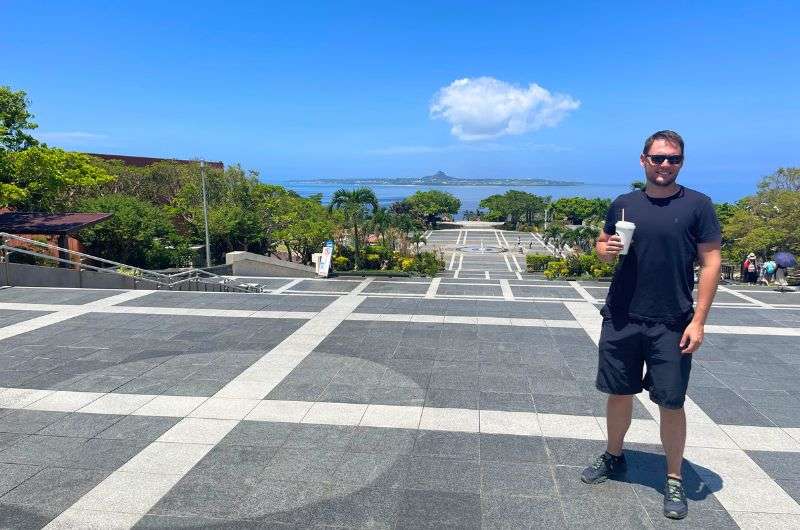
We’ve seen the museums and now me my milkshake and are ready to go to the next beach!
- Distance from last stop: Located within Ocean Expo Park, a short walk
- Time spent here: 30 minutes or more, depending on how beachy you’re feeling
- Tip: It’s 3 beaches in one!
After immersing yourself in marine life and ocean exploration, unwind at the Ocean Expo Beach, officially named Emerald Beach. Hope you don’t feel like a fish out of water! Haha! Oh, I’m hilarious.
You can walk there from wherever you are in Ocean Expo Park, unless you want to save yourself some steps and move your car to the parking lot closest to the beach. Not worth it in my opinion.
What to Expect from Emerald Beach
Emerald Beach is the beach I enjoyed most in Okinawa. Maybe because of the whole Churaumi experience, but more likely because I did have to worry about all the sea snakes and critters, as the beach has safety nets in the water. So no sea critters there. Hence, so many people were swimming there.
Actually, it’s split into 3 parts, where one is officially a “play beach”, one’s a “beach with a view”, and the last one is a “rest beach”. Each faces a different direction.
It’s an ideal spot for a swim (there are lifeguards on duty who’ll point you to the right swimming spots) or just a little rest. The beach is well-maintained and not too crowded, making it a perfect place to relax and enjoy some fun in the sun. There are a few shaded sitting areas as well if the sun becomes too much for you.
Pro Tip: There is are quite nice international buffet behind the beach that I liked. I got some Mexican food from the POV of Japanese – so Jaxican.
Emerald Beach is your last stop in Ocean Expo Park. Once you’re done, you’ll start heading back down along the coast to Naha. But there are a couple more stops on the way…
Day 2, stop 4: Cape Manzamo

Interesting reef formations in Cape Manzamo (this is supposed to be an elephant’s trunk)
- Distance from last stop: 43 km (27 mi), a 1-hour drive
- Time spent here: 20 minutes
- Price: JPY 100 (USD not even 1 dollar)
- Tip: There are plenty of places to get refreshments in the air-conditioned building right by the cliffs.
First stop on your drive down to Naha is Cape Manzamo, a scenic spot with impressive limestone cliffs and sweeping views of the East China Sea. Despite its natural beauty, the area has been built up to a slightly ridiculous extent, pushing Cape Manzamo close to tourist trap territory.
The "Manzamo Area Revitalization Facility" sounds intriguing, but it's actually a shopping mall filled with souvenir shops and a food court. The observation deck on the third floor does offer nice views, though.
What to Expect at Cape Manzamo
Expect plenty of parking—there are two huge lots, seemingly trying to prove King Sho Kei right. Fun fact: Legend has it that the Ryukyu King Sho Kei himself admired this spot, claiming it was vast enough to seat thousands. The name "Manzamo" means "a field for 10,000 people”.
There's a paved walkway making a loop from the facility to the cliffs and back, which you can easily stroll in about 10 minutes. The entrance fee is JPY 100, and it is paid in the mall, err, I mean revitalization facility.
Despite the commercial buildup, the cliffs and views are genuinely beautiful and worth the visit. Spend about 20 minutes here soaking in the dramatic seascape and snapping some photos.
This isn’t the only spectacular coastal view Okinawa has to offer—tomorrow, you'll continue your cliffside adventure with visits to Kouri Bridge Viewpoint and Cape Hedo. Each spot offers its own unique perspective of Okinawa’s coastline, so stay tuned for more amazing viewpoints!
Day 2, stop 5: American Village (optional)
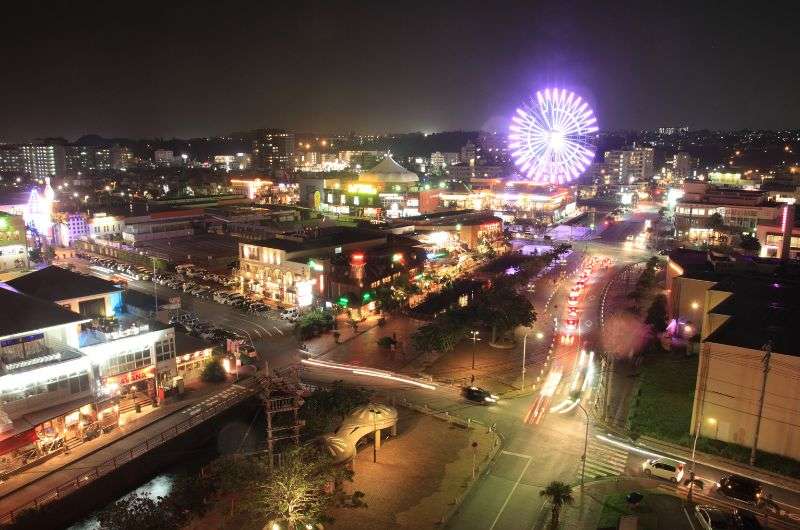
Spend the evening in the kitschy American Village
- Distance from last stop: 28 km (17 mi), a 35-minute drive
- Time spent here: 1 hour or more
- Tip: Hop on the Ferris wheel for views, especially if you time it for sunset.
Last and perhaps least, end your second day exploring Okinawa with a visit to the American Village. It’s a quirky mix of shops, restaurants, and entertainment options, styled to resemble a retro American town.
What to Expect at American Village in Okinawa
It’s an outdoor area lining a canal where you’ll find everything from tacos and burgers to a Red Lobster (American chain restaurant), stores selling American brand clothing, and even all-year Christmas decorations!
I know, that’s one thing you didn’t know you needed during a trip to Japan, right? While it might seem kitschy, I know you’ll want to stop by there anyway, so I’m including it on this itinerary. But yeah, it’s exactly what it sounds like, so set your expectations low and take it as it is—a peculiar experience in a small Japanese town.
Did I mention there’s a Ferris wheel?
After a packed day of exploring, head back to the Okinawa EXES Naha for a well-deserved rest. Enjoy their top-notch amenities and perhaps a relaxing dip in the pool.
Day 3 of Okinawa itinerary: Scenic views all the way up to the northern tip
Get the route of Day 3 already mapped out on Google Maps
Main sites visited on day 3: Shurijo Castle, Nabee Beach with snorkeling and kayaking, Kouri Bridge Viewpoint and beach, Cape Hedo
Hotel recommendations: Okinawa EXES Naha
Today, you’ll be driving all the way to the northern tip of Okinawa. But first, …
Day 3, stop 1: Shurijo Castle - UNESCO World Heritage Site
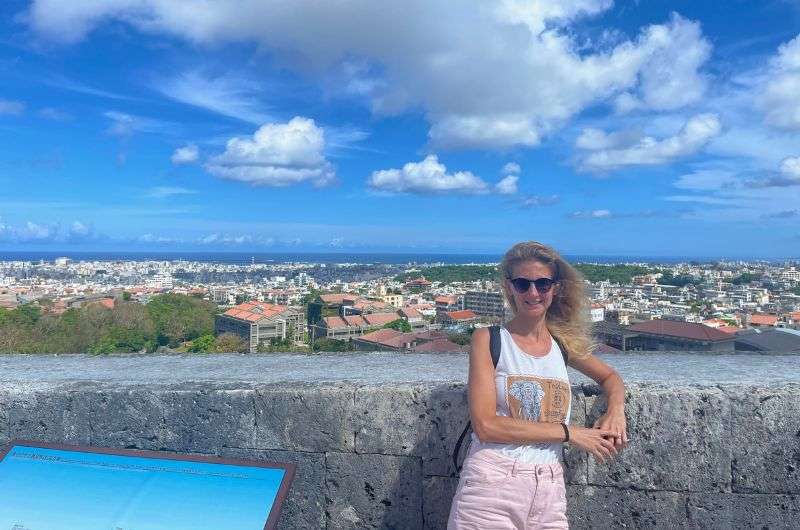
Wonderful view from the Shuriko Castle walls
- Distance from hotel EXES Naha: 5 km (3 mi), a 15-minute drive
- Time spent here: 1 hour
- Price: JPY 400 (USD 2.50)
- Opening hours: 8 am–7 pm (8 pm in the summer)
- Tip: Currently under full reconstruction, but at least you can see it happening!
What to Expect at Shurijo Castle
Kick off your final day in Okinawa with a visit to Shurijo Castle, the main castle of the Ryukyu Kingdom. This isn't just your run-of-the-mill castle; it's a sprawling complex that'll leave you in awe with just how ‘castle-y’ it is!
As the primary residence of the Ryukyu kings, it was designed to be more fortified and thoughtfully laid out than many mainland Japanese castles. The architecture even brings to mind the ruins of Mexico and the Mayan civilization.
Fun facts about the Ryukyu Kingdom
- The Ryukyu Kingdom existed from the 15th century until it was annexed by Japan in 1879.
- Thanks to its strategic location, the Ryukyu Kingdom became a major trading hub. It established trade relations with powerful neighbors like China, Japan, and Korea.
- The Ryukyu Kingdom maintained a tributary relationship with China, which allowed it to prosper under the protection of the Ming and Qing dynasties.
- Traditional music, dance, festivals, and crafts are still celebrated and practiced today, making Okinawa a unique blend of Japanese and Ryukyuan heritage.
- Karate, the martial art that became famous worldwide, originated in the Ryukyu Kingdom.
Shurijo Castle complex includes impressive walls, gates, and beautifully restored gardens. But there’s currently a big BUT. The entire bright red castle is under massive reconstruction.
They have built a hangar over it after the entire thing burned down to the ground in 2019, giving you a spectacular view of… well, diddly squat. We’re in the middle of 2024 right now, and it’s expected to take another 3 years before the project is finished.
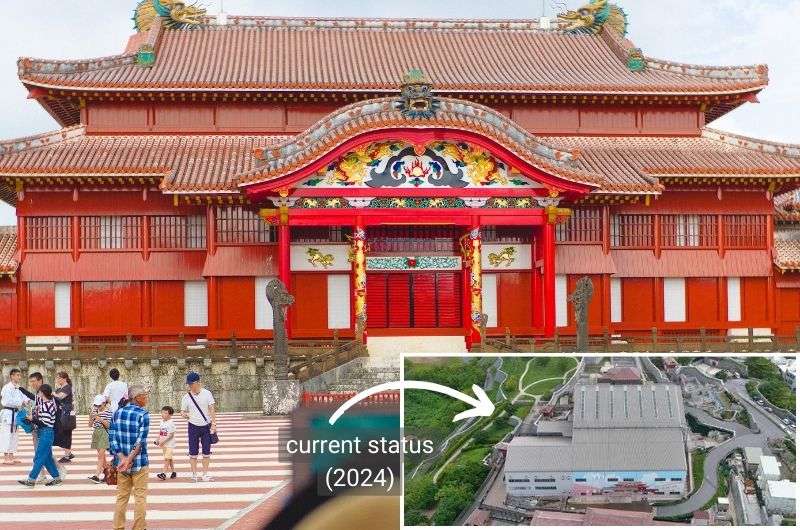
Shurijo Castle is under complete reconstruction after a fire. The entire main building is being rebuilt under a hangar
On the bright side, you can still get a pretty cool glimpse of how such a massive reconstruction works by checking out the exhibits and peeking through the glass walls, where you can see the workers working like busy bees on the new wooden structure.
So, while you might not get the full Shurijo Castle experience, you’ll at least walk away with a unique behind-the-scenes look at its rebirth. It was a pretty clever decision not to close the entire thing, but instead to invite the public in to see what was happening. Educational, I like that!
Day 3, stop 2: Nabee Beach area and kayaking
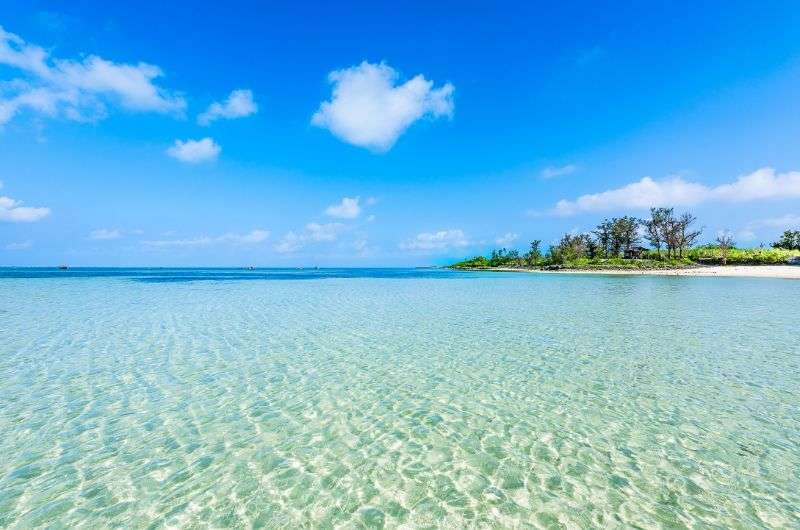
Next up, who’s up for kayaking in the crystal-clear seas around Nabee Beach?
- Distance from last stop: 43 km (26 mi), a 45-minute drive
- Time spent here: 2–3 hours
- Price: JPY 6,500 (USD 40) for a 3-hour kayaking + snorkeling trip
- Tip: Book your kayaking tour in advance to get the timing right; tours can last a few hours.
How to Get to the Nabee Beach
Alright, time to buckle up and drive to Nabee Beach area, which, if you look at a map, is right next to Cape Manzamo, which you visited yesterday. If you’re like me and hate driving the same road over and over again, you’ll be happy to learn there are more ways to get there. So, choose your route and off you go. It should take you about 45 minutes, no matter which route you take.
What to Expect at Nabee Beach
The reefs around Nabee Beach and the surrounding areas are particularly vibrant and teeming with life, which is why this next stop isn’t about beach time, it’s about water activities! Whether you're into kayaking, paddle boarding, or snorkeling, you’ll find plenty to do.
While Nabee Beach is a beautiful spot (apart from that eyesore of a hotel that you have a “great” view of), don’t limit yourself to just one beach. There are kayaking shops operating from various beaches in the area—check reviews on Google Maps before you commit—that provide guided trips, including sea kayaking, mangrove kayaking, paddle boarding, and different combinations of all of these with snorkeling.
You can even go sea kayaking in clear-bottom boats or explore hidden sea caves. One well-reviewed option is Kayak Club Good Life, known for its friendly guides and great tours.
Make sure to book your kayaking trip in advance, as they usually take a few hours, and you’ll need to plan your time accordingly. Sample price: A 3-hour sea kayaking and snorkeling tour can cost around JPY 6500 (USD 40).
Okinawa Reefs
Okinawa is home to an incredible array of marine life, including over 200 species of corals and countless species of fish, crustaceans, and mollusks. You might spot clownfish, butterflyfish, sea turtles, and even the occasional manta ray.
The waters around Okinawa are crystal clear, providing excellent visibility. Thanks to conservation efforts, many of Okinawa’s reefs are in good health, offering some of the best snorkeling and diving experiences in Japan.
Day 3, stop 3: Kouri Bridge Viewpoint and beach
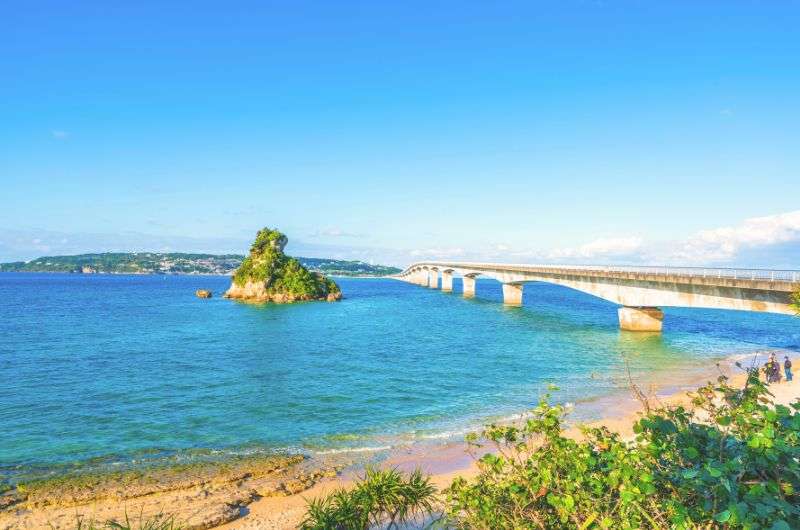
Stopping at Kouri Bridge viewpoint
- Distance from last stop: 35 km (22 mi), a 45-minute drive
- Time spent here: 15–45 minutes (if you’re also crossing the bridge)
- Tip: Stop by a local shop for some Kouri Island specialties, like sea salt ice cream!
What to Expect at Kouri Bridge
Drive over to Kouri Bridge next, about a 45-minute drive from Nabee Beach. Kouri Bridge is an impressive 2 km (1.2 mi) long bridge that connects Okinawa Island to Kouri Island. The bridge itself is an engineering marvel, but it's the view that steals the show.
On a sunny day, the waters around the bridge are a mesmerizing turquoise, giving you that perfect tropical island vibe. Stop at the “viewpoint” right before the bridge for a photo op. It’s just a little parking area with a café, but you can wander down onto the sand and take your selfies and whatnot there.
Visiting the Kouri Island
Kouri Island is a small island lined with beautiful beaches mostly on the northern side. It's known for its relaxed atmosphere and natural beauty. I didn’t venture onto the island itself too much, because stopping at the viewpoint was enough for me, and I can imagine all the beaches are pretty similar—gorgeous, of course, but if you’ve seen one, you’ve seen them all.
If you wanted to see the bridge up close and get some beach time in, you could drive over Kouri Bridge and stop right at the end of it, at Kouri Beach. I’m guessing you won’t waste time actually getting into the water, but it’s worth a quick stop. There’s even a small park and harbor that you could take a little walk in.
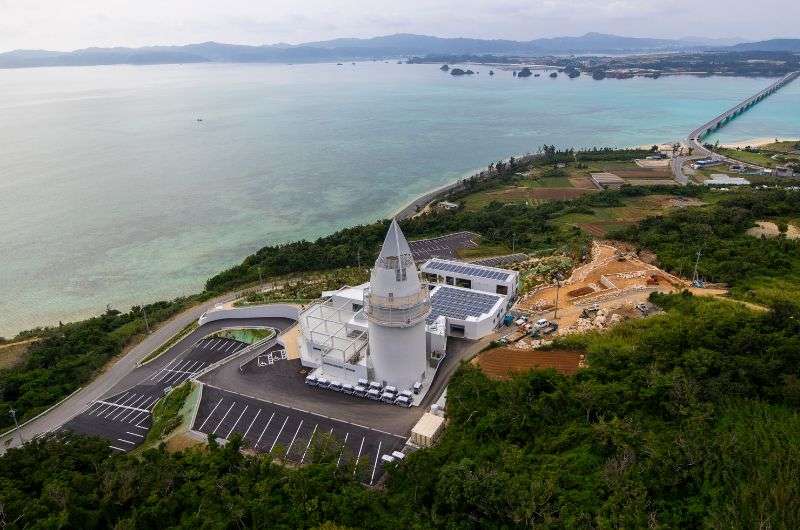
Kouri Ocean Tower
If you do have extra time and want to explore Kouri Island some more, you could check out Kouri Ocean Tower. It’s a rather hideous building in my humble opinion, but it has an observation tower and a seashell museum.
The views from the top are reportedly nice, but given that kayaking already took up a big chunk of your day and this itinerary is rapidly nearing its end, it's best to move on after soaking in the views from the viewpoint.
Enjoy the panoramic views, take some photos, and then get ready for your final adventure of the day at Cape Hedo.
Day 3, stop 4: Cape Hedo - East China Sea Views
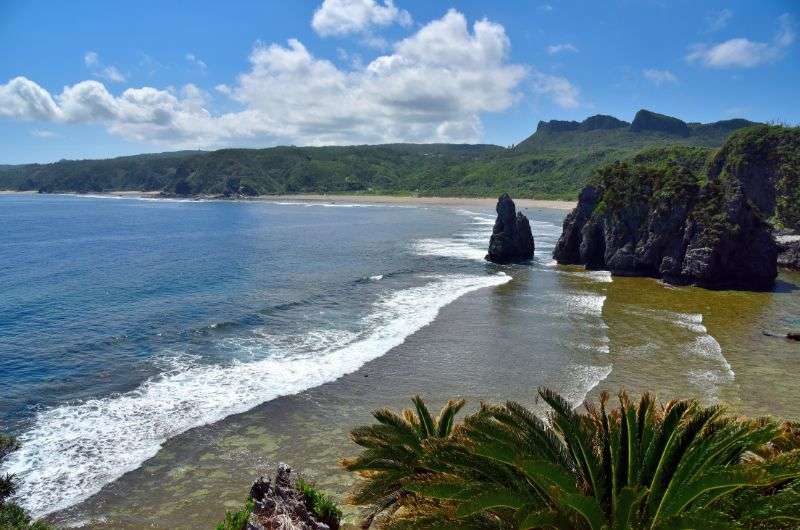
Cape Hedo—the northernmost point of Okinawa
Distance from last stop: 48 km (30 mi), a 1-hour drive
Time spent here: 1 hour
Tip: Head off the main trail for a more secluded experience and to find a little worship area on the cliffs.
Finally, make your way to Cape Hedo, the northernmost point of Okinawa. This rugged, windswept cape offers dramatic views of the ocean crashing against the cliffs. The natural beauty of this spot is breathtaking and provides a fitting end to your Okinawa itinerary.
What to Expect at Cape Hedo
The views of the East China Sea meeting the Pacific Ocean are simply spectacular, so don’t be like “nah, I don’t want to drive all that way to see the sea again”—that would be a huge mistake.
There are a couple of cafés where you can grab a drink or a light snack, and an observatory building with a terrace. Luckily, with views this nice, you won’t care what you’re observing them from, but let’s just say you’ll want to focus your gaze on the sea views, not on that building.
Cape Hedo Trail
The trail at Cape Hedo is mostly dirt, offering a more natural and pleasant walking experience compared to the asphalt at Cape Manzamo. Take your time to stroll along and soak in the views from every which way. You’ll see it all in 20 minutes or less, and that includes time to ponder why there is a statue of a huge chicken there.
Bonus: Venture off the main path for about 5 minutes to find a quieter spot on the cliffs with a small worship area enshrining the dragon god, perfect for a moment away from the crowds.
The cliffs at Cape Hedo are rugged and dramatic, with sharp, jagged rocks jutting out into the sea. The contrast between the deep blue of the ocean and the grey limestone is stunning. The waves crashing against the rocks add to the wild beauty of the place.
Fun fact: Cape Hedo is the endpoint of the 10,000 km long-distance walking trail known as the Japan Trail, which stretches from Hokkaido to Okinawa. Imagine completing that epic journey and being rewarded with the incredible views from Cape Hedo—nice choice for the finish line!
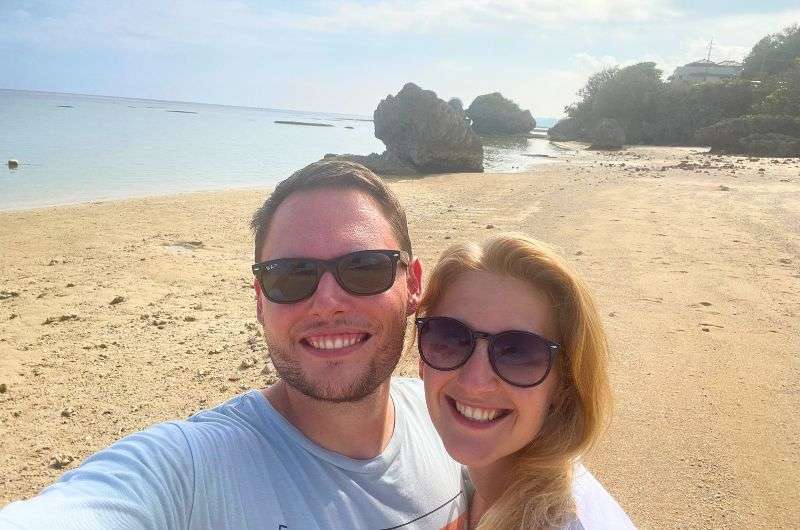
Enjoy your time at the beach one last time and hop on your next Next Level of Travel adventure!
And that’s all you have time for on your Okinawa itinerary! The drive back to Naha takes about 2 hours, so take one last look at the island, grab a nice dinner, and off you go to your next destination.
Where to next?
You’re obviously going to spend some time in Tokyo, though if you listen to me, you’ll minimize your time there and spend it in much more spectacular spots, like Nikko, Kyoto + Nara, or Hakone.
FAQs
How many days are enough for Okinawa?
Three days is the minimum you need to get a good taste of Okinawa, but honestly, I can even imagine spending seven days to really crisscross the island and see all it has to offer. If you add in beach time and the amazing food (my favorite out of all of Japan!), It’s easy to fill your days, no matter how long your Okinawa itinerary is. If you can, give yourself a full week to enjoy everything from cultural sites to natural wonders without rushing.
Is Okinawa expensive to visit?
Okinawa is generally cheaper than Kyoto, which might come as a pleasant surprise. Prices for accommodation, food, and activities are quite reasonable, and yes, they accept tips here! Very weird after a couple of weeks, making sure NOT to tip, since it’s offensive in most other places in Japan.
Is Okinawa worth it?
Absolutely, Okinawa is worth visiting, and I say that even though I had my serious doubts. I didn't even consider visiting until my girlfriend insisted on adding beaches to our Japan trip, but I'm so glad we went. Okinawa is quite different from other parts of Japan, offering a laid-back paradise island vibe. Great food, fun water activities, tons of history—all that adds to Okinawa’s allure. Besides, you'll encounter the anomaly of US airbases—so don't be surprised to see fighter planes flying overhead. It adds an unexpected twist to the island experience!
What's the best way to get around Okinawa?
Nothing beats self-driving around Okinawa. I always rent a car and recommend you do the same. I can’t imagine getting around using public transportation; it’s available, but it's limited, and a car gives you the flexibility to explore at your own pace. It’s a no-brainer. The island’s scenic drives, especially along the coast, are part of the adventure. Just remember to bring your international driving permit!
This post contains affiliate links. I earn a small commission if you make bookings through my links, at no additional cost to you. Thank you for your support!
Overview of your 3 days in Okinawa and a map
My top tips for visiting Okinawa
Day 1 of the Okinawa itinerary: Southern Okinawa
Day 2 of Okinawa itinerary: Ocean Expo Park
Day 3 of Okinawa itinerary: Scenic views all the way up to the northern tip
How many days are enough for Okinawa?


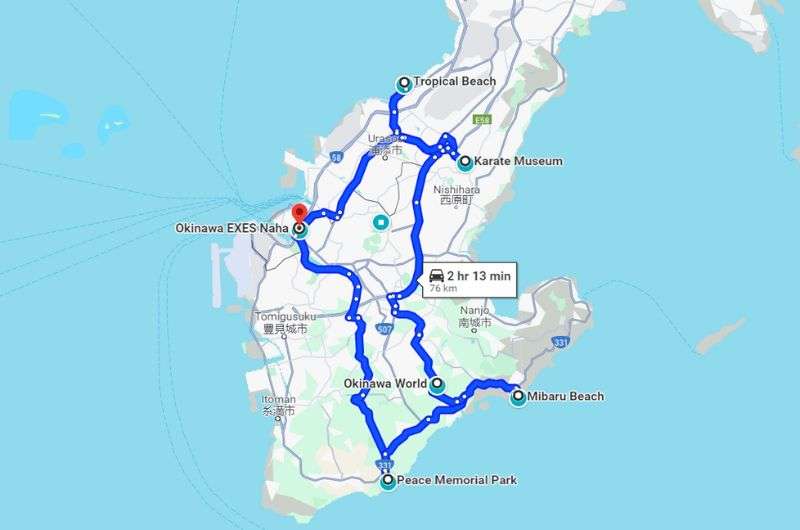
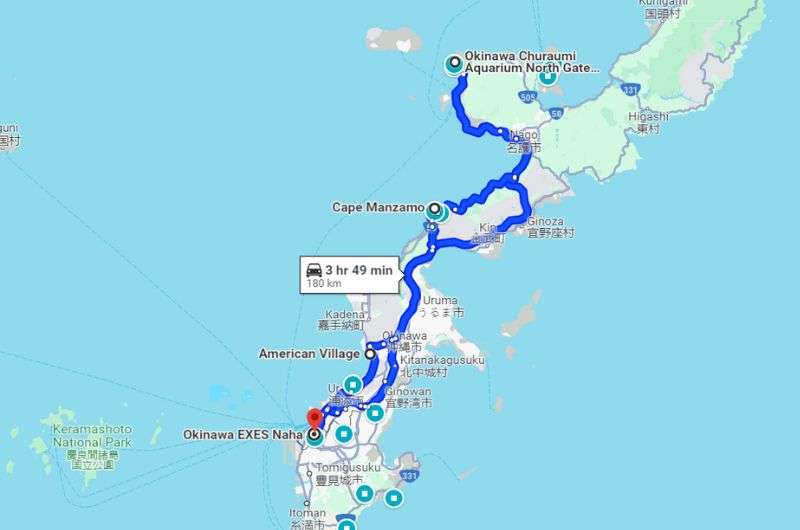
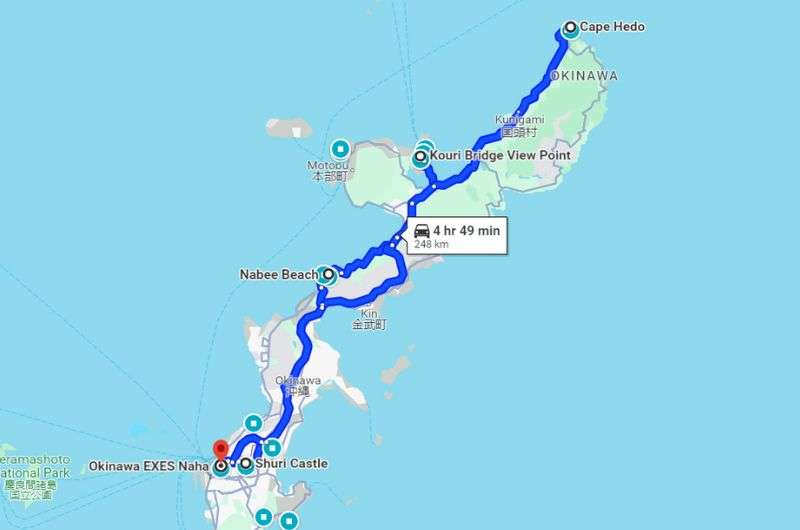
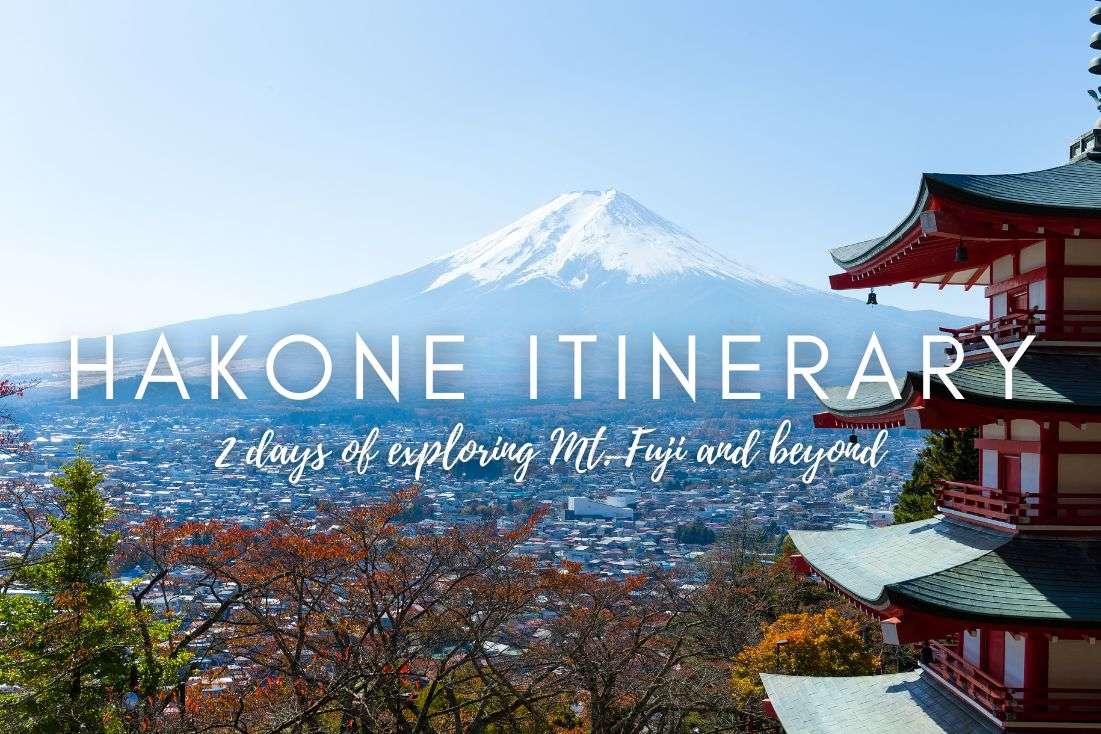
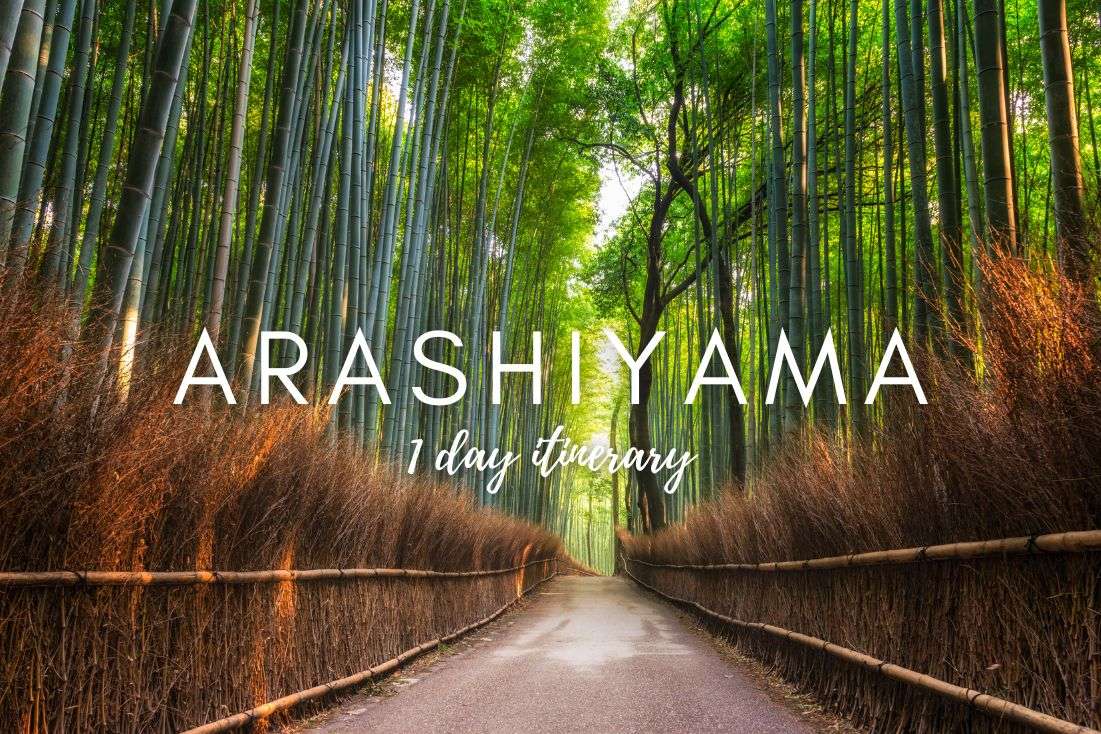
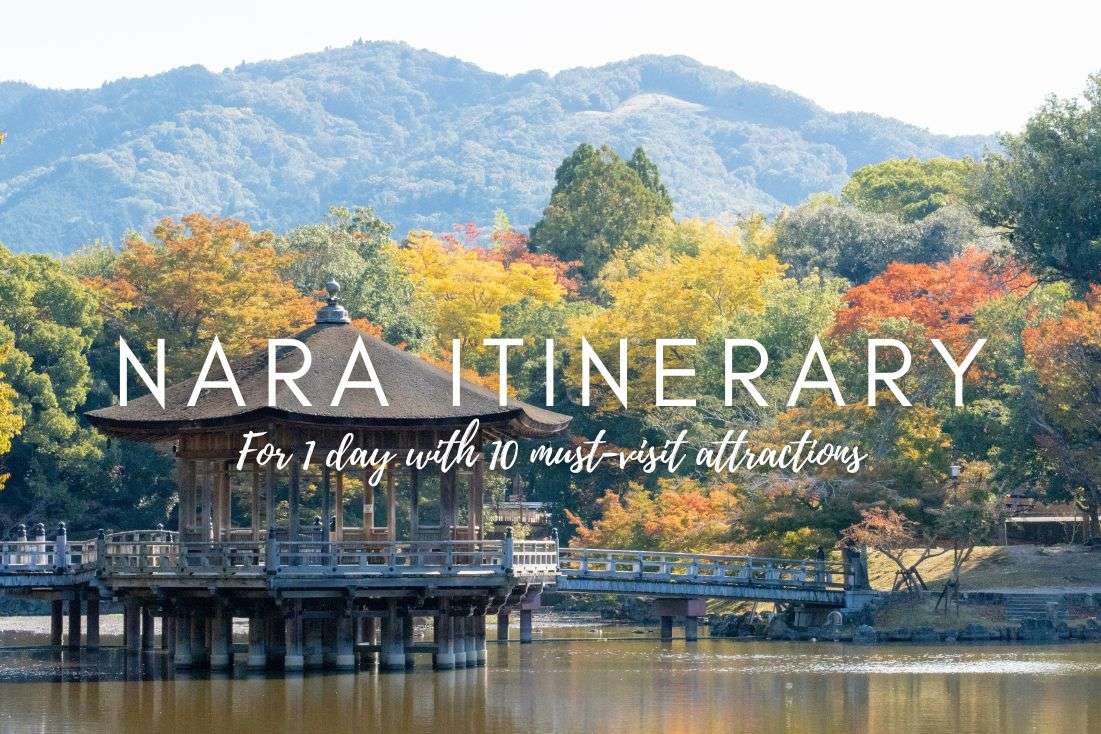





Comments | Thoughts? Give us a shout!